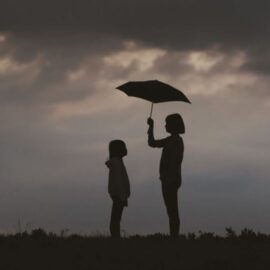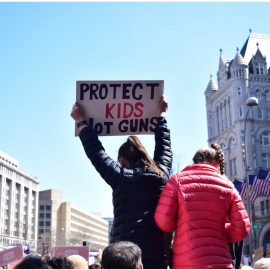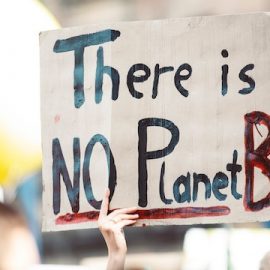

This article is an excerpt from the Shortform book guide to "Unbound" by Tarana Burke. Shortform has the world's best summaries and analyses of books you should be reading.
Like this article? Sign up for a free trial here.
How did Tarana Burke prevent child abuse after giving birth to her child, Kaia? How did Burke end the abusive relationship with Kaia’s father?
Although Burke was an activist before giving birth to Kaia, it was ultimately motherhood that prompted her to step up and form her own movement. Burke explains how her own abusive relationship and an interaction with Reverend James Luther Bevel compelled her to protect her child.
Continue reading to learn how Burke protected Kaia from abuse.
The Power of Motherhood
After Burke moved to Selma, her on-and-off boyfriend, Sean, joined her. She reveals that Sean had always been abusive—for example, when they were in high school, he threatened to kill himself if she moved away for college. But she didn’t realize that he was abusive until an incident that occurred after she became pregnant at age 23. During an argument, Sean attacked her, trapped her for hours, threatened to kill her, and finally raped her. She realized that this was different from other fights they’d had—he took advantage of her pregnancy, which made self-defense more difficult. She knew that she didn’t want to expose her child to such an unhealthy relationship and wanted to prevent child abuse, so a few days later, she broke up with him and kicked him out.
(Shortform note: Many people find it difficult to end abusive relationships. One reason for this is that it can be difficult to recognize that your relationship is abusive in the first place—typically, people enter relationships on good terms with one another, but the abusive partner makes subtle behavioral changes over time that can be hard to pick up on until a clear threat occurs. Pregnancy can also make it difficult to leave an abuser. Studies show that abuse often escalates during pregnancy and that pregnancy increases a woman’s likelihood of being murdered by an abusive partner. Despite the dangers associated with leaving an abusive relationship while pregnant, pregnancy often motivates women to leave out of a desire to protect their children.)
Burke Protected Her Child From Community Failures
Burke explains that by virtue of her activism in Selma, she’d built up a community in whose hands she felt she could entrust her child. So after the birth of her child, Kaia, who is nonbinary, she often relied on her community for childcare or brought Kaia to work with her. However, over time, Burke faced a series of major betrayals by key members of her community, including Sanders, the mentor who’d helped her get into college. Let’s explore two of these betrayals:
First, at a community event where Burke was working, Sanders’s adult nephew attempted to molest Kaia. When Kaia and their friend ran to Burke for help, Burke punched the man. Although news of the altercation spread through the community, Sanders sent her nephew to work alongside Burke at the local museum, where Burke often brought her child. When Burke and Kaia saw him waiting outside the museum from their car, Kaia urinated on themself with fear. (Shortform note: Bathroom accidents are a commonly recognized sign of sexual abuse in children.)
Burke addressed the issue with Sanders, who argued that she hadn’t known the whole story and couldn’t deny the man work based on a rumor about petty conflict. This claim was false and only served to deflect blame, Burke adds.
Second, Sanders invited Reverend James Luther Bevel, a civil rights activist who’d worked alongside Martin Luther King Jr., to work with children in Selma. Burke explains that she distrusted Bevel from the start because he made inappropriate, sex-focused statements around the children he taught. Later, Burke discovered that Bevel was a pedophile who’d molested his own children and that Sanders had known this about Bevel when she invited him to join the community. Burke was furious—her own child and her community’s children had been needlessly exposed to serious danger. As a result, she stopped engaging with Sanders. (Shortform note: In 2008, Bevel received a 15-year prison sentence for his sexual crimes.)
| Cultural Betrayal Trauma These two betrayals may have resulted in what psychologist Jennifer Gómez refers to as cultural betrayal trauma. According to this paradigm, marginalized people build community with one another to help protect themselves from societal trauma (like racism, against which Burke’s community in Selma was organized). When someone inside the community experiences violence at the hands of another community member, it’s not only traumatic on a personal level; it’s also traumatic on a cultural level, as it shatters the protective trust around which the community was initially organized. Cultural betrayal trauma can be exacerbated by what Gómez calls (intra)cultural pressure: Cultural authorities or others within the community might prioritize the perpetrator’s needs, or the benefits the perpetrator provides to the community, over the victim’s needs. Burke experienced (intra)cultural pressure during both betrayals: first, when Sanders argued that the man who attempted to molest Kaia deserved an opportunity to work, and second, when Burke realized that by inviting Bevel to work with children, Sanders had decided Bevel’s contributions to society outweighed the need to ensure children’s safety. When sufficiently negative, cultural betrayal trauma can result in cultural fractures—for example, Gómez explains that people who experience cultural betrayal trauma might internalize stereotypes related to their cultural identity or pull away from their communities. We’ll discuss the effect these betrayals had on Burke’s relationship to her community later in this guide. |

———End of Preview———
Like what you just read? Read the rest of the world's best book summary and analysis of Tarana Burke's "Unbound" at Shortform.
Here's what you'll find in our full Unbound summary:
- The origin of the viral phrase “me too”
- What Tarana Burke did to heal from the experience of childhood sexual abuse
- The story of the #MeToo movement






